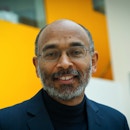- Speaker
-
 Emery N. Brown, M.D., Ph.D.Trustee, Simons Foundation
Emery N. Brown, M.D., Ph.D.Trustee, Simons Foundation
Edward Hood Taplin Professor of Medical Engineering and professor of computational neuroscience, Massachusetts Institute of Technology
Warren M. Zapol Professor of Anaesthesia, Harvard Medical School
Presidential Lectures are a series of free public colloquia spotlighting groundbreaking research across four themes: neuroscience and autism science, physics, biology, and mathematics and computer science. These curated, high-level scientific talks feature leading scientists and mathematicians and are designed to foster discussion and drive discovery within the New York City research community. We invite those interested in these topics to join us for this weekly lecture series.
General anesthesia is a drug-induced, reversible condition comprised of five behavioral states: unconsciousness, amnesia (loss of memory), antinociception (loss of pain sensation), akinesia (immobility), and hemodynamic stability with control of the stress response.
In this lecture, Emery Brown will discuss work by him and his colleagues showing that a primary mechanism through which anesthetics create these altered states of arousal is by initiating and maintaining highly structured oscillations. These oscillations impair communication among brain regions. Brown and collaborators illustrate this effect by presenting human and non-human primate studies using high-density EEG and intracranial recordings. These studies have allowed them to give a detailed characterization of the neurophysiology of loss and recovery of consciousness due to propofol, and more recently, ketamine. In addition, they show how these dynamics change systematically with different anesthetic classes and with age.
Consequently, they have developed a principled, neuroscience-based paradigm for using the EEG to monitor the brain states of patients receiving general anesthesia. In addition, they demonstrate that the state of general anesthesia can be rapidly reversed by activating specific brain circuits. Finally, they show that the state of general anesthesia can be controlled using closed-loop feedback control systems. The success of their research has depended critically on tight coupling of experiments, signal processing research and mathematical modeling.
To attend this in-person event, you will need to register in advance and provide:
- Acceptable proof of vaccination (vaccine card/certificate, a copy or photo of vaccine card/certificate or electronic NYS Excelsior Pass or NJ Docket Pass)
- Photo ID
- Eventbrite ticket confirmation email with QR code
- Simons Foundation Health Screening Questionnaire approval email
Entrance will not be granted without this documentation.
On-site registration will not be permitted. Walk-in entry will be denied.
